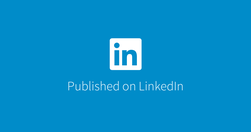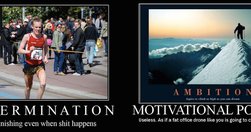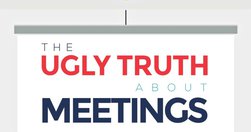Relevant Overviews
- Communication Strategy
- Content Strategy
- Online Strategy
- Online Community Management
- Social Media Strategy
- Digital Transformation
- Change & Project Management
- Personal Productivity
- Innovation Strategy
- Communications Tactics
- Psychology
- Social Web
- Politics
- Communications Strategy
- Science&Technology
- Business

"decision makers get stuck in a memory loop and can only predict the future as a reflection of the past... A way around... is a speed-dating version of scenario planning, one that takes hours rather than months... get participants out of their usual frame of reference, opening their eyes to a possible future that would require very different type…

This one's a mustread, helping you identify and understand all four 'Dark Tetrad' personality types (everyday sadists, narcissists, Machiavellians & psychopaths). Useful not just for navigating your own organisation, but also that of your client ... "Blessed with a surfeit of confidence and knack for lying, they dazzle in interviews, make great…

How industrial-era management structures hinder work today: "The industrial era approach to getting something done is to first create an organization ... metaphorically still a picture of walls defining who is inside and who is outside a particular box.... This way of thinking was acceptable in repetitive work ... As a result, organizational des…
"In a previous post, I outlined the benefits of Five Whys... Today, I want to talk about the mechanics of Five Whys in greater detail." - Lessons Learned: How to conduct a Five Whys root cause analysis
"I have come to believe that this technique should be used for all kinds of defects ... we use the defect as an opportunity to find out what's wrong with our process, and make a small adjustment. By continuously adjusting, we eventually build up a robust series of defenses that prevent problems from happening.... breaking down the "time/quality/c…

"The Five Whys technique was developed and fine-tuned within the Toyota Motor Corporation as a critical component of its problem-solving training... "by repeating why five times, the nature of the problem as well as its solution becomes clear." ... dig into each problem that arose until they found the root cause. "Observe the production floor w…

A timely and interesting article... "Gossip is an effective way of achieving these goals in an unhealthy social system. People engage in gossip when they lack trust or efficacy. We become consumers of gossip when we don’t trust formal channels... We become purveyors of it when we feel we can’t raise sensitive issues more directly... The problem w…

Excellent intro to "Contextual intelligence: the ability to understand the limits of our knowledge and to adapt that knowledge to an environment different from the one in which it was developed. ... The most difficult work is often the “soft” work of adjusting mental models, learning to differentiate between universal principles and their specifi…
" What was simply needed was to tweak the ‘rules of the game’ and to incentivize the right people so as to drive the right behaviors. In other words, by turning a predictable work process that had always led to the corresponding predictable sub-optimal outcomes into something fresh that talked to people’s EQ, we managed to make ‘work as natural as…

"businesses ... can, without realizing it, generate an environment hostile to innovation... frontline business units... are optimized to relatively short-term goals that are anchored in what they are currently doing or selling rather than in what they could be doing differently. As a result, line managers instinctively reject innovations that won…

"Instead of trying to make them happy, ask them to do something hard... @the opportunity to use skills and abilities” has displaced “job security” as the top driver of satisfaction, and it consistently ranks among the top two... Employees don’t just want their skills used; they want them stretched.... Respondents ... started to feel stale after o…

"So, does engagement actually cause higher performance, or are high-performing employees just more engaged?... In one of the few robust studies to examine this issue, Ben Schneider and colleagues mined archival engagement and performance data for several Fortune 100 companies. " - To Motivate Employees, Help Them Do Their Jobs Better

"... is to foster alignment and enthusiasm toward the right goal. I’m thinking of official leaders (and myself) when writing the above, but there are official and unofficial leaders in every organization. " Very short post, very worth reading. Sometimes the simplest insights are the most powerful. - The Job of Leadership — Inside Medium — Medium

The basic reasons we launched I-Labs are all here: "The most powerful way of learning is ... to have conversation... the best examples of great insight nearly always come from cases where people shared knowledge or experience.... every organisation is sitting on a wealth of information that potentially contains insight... This information is ly…

"Employees responded that only 54% of the time spent in meetings was time well spent. They cited unclear meeting purpose, unnecessary standing meetings, overly long meetings and unnecessary attendees as reasons for unproductive meetings." - Kill the weekly meeting – Quartz

Lessmeeting looks like a cool tool. Even if you don't try it: "Below is our best practices guide to writing meeting agendas, capturing meeting minutes and following up on action items:"

"The worst part about meetings? Usually, they lead to more meetings." A lot to like here. I have 3 meetings with upper mgt per month, and a short Skypescrum with my colleagues every morning. The rest of the time I work from home. Sounds like many have a worse time: "weekly meetings ... often have no justification for existing and usually can be …

"We couldn't understand why people without technical knowledge had to tell programmers "what" to do and, furthermore, they had to supervise "how" programmers did it." At last. Someone said it. And also quite a bit more about the timesucks that are meetings, email and commuting. These guys avoid all of them, work 4 days/week and are growing …
"the biggest impact on competitive advantage comes not from products, processes or technology, but empowered employees. And with the lines between Internal and External Communication becoming increasingly blurred, ensuring your people are engaged and empowered has never been more critical.... Leading Internal Communication teams are already bla…

"Government around the world is pretty good at thinking about its own needs — they often put their political needs followed by the policy needs. The actual machine of government comes second. The third need then generally becomes the system needs, so the IT or whatever system’s driving it... the user comes a poor fourth, really." Turning that ups…

"In a circumstance where two people who report to you are having an acrimonious disagreement, you will need a thoughtful approach with some options to resolve the problem. " - Conflict Resolution: Being a Successful Manager | LinkedIn

Excellent insider's view of both theory & practice... "My first holacracy meeting made me want to quit my job. One year later, ... I can’t imagine going back to our old way of working.... a holacracy eschews titles and instead builds a chain of command based on the work that needs to be done. The group decides to distribute tasks. Those responsi…

"this is the eternal founder dilemma — which hats do you wear, which ones do you give to others, which ones do you forget about? all in less time than you need, while your hair is on fire & your house is burning down. Choose. but there’s one job you can’t hand off to anyone else: setting the vision and inspiring your team. that job is yours & you…

Just listed to HBR's podcast interview with Pentland. Will probably get this book. Typically good roundup by Greg Satell: "Pentland’s research has found that the most important predictor of success in a group is the amount—not the content—of social interaction. It is exposure to peer activity that drives learning and changes in behavior.... in …
A whole bunch of reasons why the wrong consultants are hired for the wrong reasons: "When we don’t know much about somebody, we ... think about people in over-optimistic ways...what normal individual can stand up against an outsider or expert made up of pixie dust and rainbows? ... when we go looking for a better expert ... we tend to find them…

"In the end, meetings turn out to be a waste of time — just people sitting around, chatting, wasting hours of precious time (even preparing for it). Approximately 15 percent of your time working in any company is spent in meetings. That number is more than doubled for middle managers, while executives spend 50% of their time stuck in meetings."
'Innovation' threaded its way through a lot of the resources added to my TumblrHub last week: from innovation-friendly management through to innovative Content Management Systems for tomorrow's newsmedia business models and personal productivity tools.
Brian Solis on LinkedIn: "a pattern of best practices ... these pillars represent the cultural capstones that the most innovative companies in the world invest in to stay ahead of the curve." - How to Build a Culture of Innovation Pt. 2: The 12 Pillars of Innovation | LinkedIn

Nothing in here about information flow management, but a lot of interesting theory about how evolutionary psychology reinforces the need to support pyramidal organisational structures. "power and winning create a self-reinforcing dynamic. Talented people associate themselves with success and attract other talented people to their side, making con…

"Performance reviews that are tied to compensation create a blame-oriented culture. It’s well known that they reinforce hierarchy, undermine collegiality, work against cooperative problem solving, discourage straight talk, and too easily become politicized. They’re self-defeating and demoralizing for all concerned. Even high performers suffer, bec…
Relevant Overviews
- Communication Strategy
- Content Strategy
- Online Strategy
- Online Community Management
- Social Media Strategy
- Digital Transformation
- Change & Project Management
- Personal Productivity
- Innovation Strategy
- Communications Tactics
- Psychology
- Social Web
- Politics
- Communications Strategy
- Science&Technology
- Business